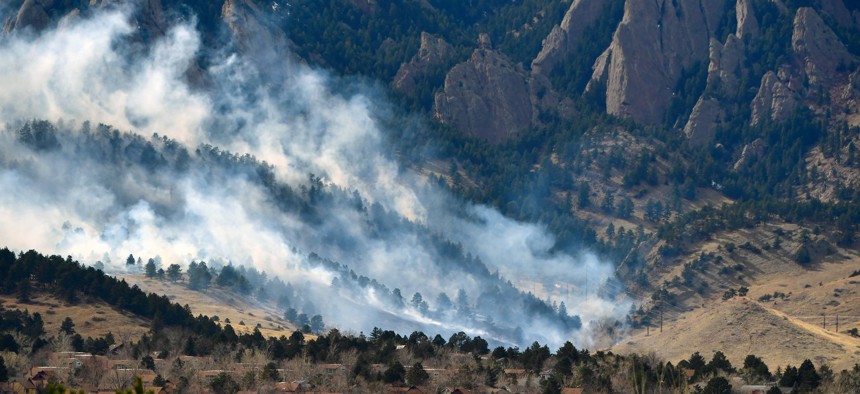
Helen H. Richardson/MediaNews Group/The Denver Post/Getty Images
The Forest Service Rushes to Hire Enough Firefighters Ahead of Wildfire Season
Stakeholders warn shortages again threaten the Biden's administration's approach to combatting the fires.
The U.S. Forest Service is scrambling to meet its hiring targets ahead of this summer’s fire season, though in some regions it is only halfway toward its goals.
Overall, the Agriculture Department agency has made significant strides in filling longstanding vacancies, reaching 90% of its goal to maintain a workforce of 11,300 firefighters. Forest Service has seen its non-firefighter cadre slashed by 40% over the last 15 years, Randy Moore, the agency’s chief, told a panel of the Senate Appropriations Committee on Wednesday, who play a critical role in fire mitigation efforts. Forest Service is aiming to grow its workforce to replace half of the 8,000 employees it lost in recent years.
While it has made some progress in rebuilding its rolls, Moore conceded some regions are only halfway to their staffing targets.
“Fifty percent sounds a little scary when thinking about the fires we’ll be facing in our various states,” said Sen. Jeff Merkely, D-Ore., who chairs the Interior Subcommittee that held Wednesday’s hearing.
Congress provided the Forest Service a total of $5.5 billion in the recent infrastructure law and the agency has set aside $1 billion for firefighter salaries and expenses. Under an order from President Biden, federal firefighters now make a minimum of $15 per hour. The infrastructure law went further to provide permanent pay increases to the firefighters and convert more of them from seasonal to full-time positions. It also created a new wildland firefighter position, instead of the more general "forestry technician" category in which they had previously served.
Still, Moore said his agency is struggling to compete with counties, states and private employers also hiring firefighters. A lot of Forest Service offers have been declined, he said.
“There’s a lot of competition in the labor market for these skills,” Moore said.
He expressed confidence his agency will be prepared, however, noting it will continue its hiring push into July, can bring on contract workers and can onboard emergency firefighters known as “administratively determined” employees. Forest Service is also adding capacity on its grants and contracting teams to build better partnerships that can help in fire prevention and mitigation work.
Sen. Lisa Murkowski, R-Alaska, the top Republican on the Interior appropriations panel, voiced skepticism in the plan, noting it is hard to hire for any job right now, let alone particularly difficult positions like wildland firefighters.
“I hope you’re right that we’ll be able to get the folks we need in time for what we expect will be a tough fire season,” Murkowski said.
Max Alonzo, a former Forest Service firefighter who now serves as national business representative for the National Federation of Federal Employees, the union that represents many FS employees, told Government Executive he took little comfort in the agency claiming it is at 90% of its staffing goal. Every year, he said, firefighters sign up for the jobs but never show up after they find better paying opportunities or quit after a week.
“There’s not enough incentive to keep people around,” Alonzo said. “They’re making hardly anything and they’re not going to be able to see their family [during fire season] and they’re not going to be able to support their family.”
While he applauded the Biden administration for boosting the federal firefighter minimum wage, he said $15 per hour was “way too little, way too late.” The infrastructure law enabled the Forest Service to boost pay by up to $20,000 per year for positions in areas that are difficult to recruit or retain, but the agency has yet to implement those increases. The delay has further frustrated staff, Alonzo said, and the Service has yet to say when it will make the changes.
Moore, the Forest Service chief, acknowledged the steps Congress and the administration have taken have not gone far enough and pledged to work with lawmakers to find longer-term solutions.
In the meantime, firefighters are still struggling. One Wyoming-based team of hotshots—the federal government’s most elite teams of wildland firefighters—has a majority of its members living in their cars outside of the district office, Alonzo said. Their team leader had to negotiate with the agency to install a port-a-potty in the parking lot.
Jonathon Golden, a former firefighter for the Forest Service and Bureau of Land Management who now consults for Grassroots Wildland Firefighters, said even Moore's rosy outlook at Wednesday's hearing made clear there are still holes in the current staffing levels. While Moore said hiring efforts will continue until July, Golden questioned how successful that would prove to be and what would happen after that date if goals had still not been met.
“The applicant pool doesn’t get any more robust the more rounds you go,” Golden said. “We’re not out of the woods yet.”







